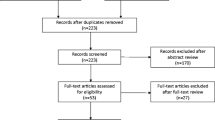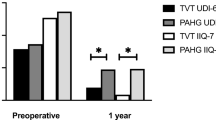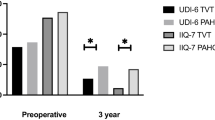Abstract
Intervention for stress urinary incontinence (SUI) is generally focused on minimizing urinary leakage. However, the overall impact of SUI therapy on patients’ quality of life is, arguably, more important than leakage outcomes. We performed a literature search to investigate the effect of urethral injection therapy on quality of life. Significant quality-of-life improvements have been observed with a number of injectable agents, while there is a distinct lack of correlation between subjective and objective outcomes. Two studies comparing urethral injection therapy with surgical intervention found superior objective efficacy with surgery, but no significant differences in quality-of-life improvements. Personal goals of patients undergoing urethral injection are yet to be explored, but there may be willingness to trade a lower success rate in favor of a more minor treatment procedure. In conclusion, quality-of-life improvements after urethral injection appear significant and comparable to those obtained with surgery. Further study of patients’ own perceptions, pre- and posttreatment, would be valuable.
Similar content being viewed by others
References
Ware JE, Snow KK, Kosinski M, Gandek B (1993) SF-36 Health Survey: manual and interpretation guide. The Health Institute, New England Medical Center, Boston
Kelleher CJ, Pleil AM, Reese PR, Burgess SM, Brodish PH (2004) How much is enough and who says so? BJOG 111:605–612
Patrick DL, Martin ML, Bushnell DM, Yalcin I, Wagner TH et al (1999) Quality of life of women with urinary incontinence: further development of the incontinence quality of life instrument (I-QOL). Urology 53:71–76
Bent AE, Foote J, Siegel S, Faerber G, Chao R et al (2001) Collagen implant for treating stress urinary incontinence in women with urethral hypermobility. J Urol 166:1354–1357
Winters JC, Chiverton A, Scarpero HM, Prats LJ Jr (2000) Collagen injection therapy in elderly women: long-term results and patient satisfaction. Urology 55:856–861
Poon CI, Zimmern PE, Wilson TS, Defreitas GA, Foreman MR (2005) Three-dimensional ultrasonography to assess long-term durability of periurethral collagen in women with stress urinary incontinence due to intrinsic sphincter deficiency. Urology 65:60–64
Fianu-Jonasson A, Larsson G, Farrelly E (2005) The Zuidex system for the treatment of stress urinary incontinence: 36-month follow-up. Abstract no. 617. In: International Continence Society (ICS) 35th annual meeting, Montreal, Canada, 28 August–2 September 2005
van Kerrebroeck P, ter Meulen F, Larsson G, Farrelly E, Edwall L et al (2004) Efficacy and safety of a novel system (NASHA/Dx copolymer using the Implacer device) for treatment of stress urinary incontinence. Urology 64:276–281
Chapple C, Haab F, Cervigni M, Dannecker C, Fianu-Jonasson A et al (2005) An open, multicentre study of NASHA/Dx gel via the Implacer for the treatment of stress urinary incontinence. Eur Urol 48:488–494
Tamanini JT, D’Ancona CA, Netto NR Jr (2004) Treatment of intrinsic sphincter deficiency using the Macroplastique Implantation System: two-year follow-up. J Endourol 18:906–911
Kothari S, Pitkin J (2002) Efficacy of periurethral silicone implants (Macroplastique) in the treatment of urinary stress incontinence and stress incontinence with detrusor overactivity—a questionnaire study. Abstract 280. In: Annual Meeting of the International Continence Society, Heidelberg, Germany, 28–30 August 2002
Anders K, Khullar V, Cardozo L, Bidmead J, Athanasiou S et al (2002) Contigen or Macroplastique? A five-year follow-up. Abstract 281. In: Annual Meeting of the International Continence Society, Heidelberg, Germany, 28–30 August 2002
Dmochowski R, Herschorn S, Corcos J, Radomski S, Pommerville P et al (2003) Multicenter randomized controlled study to evaluate Uryx® urethral bulking agent in treating female stress urinary incontinence. Abstract 341. In: 33rd Annual Meeting of the International Continence Society, Florence, Italy, 5–9 October 2003
Bano F, Barrington JW, Dyer R (2005) Comparison between porcine dermal implant (Permacol) and silicone injection (Macroplastique) for urodynamic stress incontinence. Int Urogynecol J Pelvic Floor Dysfunct 16:147–150
Corcos J, Collet JP, Shapiro S, Herschorn S, Radomski SB et al (2005) Multicenter randomized clinical trial comparing surgery and collagen injections for treatment of female stress urinary incontinence. Urology 65:898–904
Maher CF, O'Reilly BA, Dwyer PL, Carey MP, Cornish A et al (2005) Pubovaginal sling versus transurethral Macroplastique for stress urinary incontinence and intrinsic sphincter deficiency: a prospective randomised controlled trial. BJOG 112:797–801
Steele AC, Kohli N, Karram MM (2000) Periurethral collagen injection for stress incontinence with and without urethral hypermobility. Obstet Gynecol 95:327–331
Chrouser KL, Fick F, Goel A, Itano NB, Sweat SD et al (2004) Carbon coated zirconium beads in beta-glucan gel and bovine glutaraldehyde cross-linked collagen injections for intrinsic sphincter deficiency: continence and satisfaction after extended follow-up. J Urol 171:1152–1155
van Kerrebroeck P, ter Meulen F, Larsson G, Farrelly E, Edwall L et al (2004) Treatment of stress urinary incontinence using a copolymer system: impact on quality of life. BJU Int 94:1040–1043
Madjar S, Covington-Nichols C, Secrest CL (2003) New periurethral bulking agent for stress urinary incontinence: modified technique and early results. J Urol 170:2327–2329
Chapple C, Wein A, Brubaker L, Dmochowski R, Espuña Pons M et al (2005) Stress incontinence injection therapy: what is best for our patients? Eur Urol 48:552–565
Lightner D, Calvosa C, Andersen R, Klimberg I, Brito CG et al (2001) A new injectable bulking agent for treatment of stress urinary incontinence: results of a multicenter, randomized, controlled, double-blind study of Durasphere. Urology 58:12–15
Kershen RT, Appell RA (2002) De novo urge syndrome and detrusor instability after anti-incontinence surgery: current concepts, evaluation, and treatment. Curr Urol Rep 3:345–353
Chaliha C, Stanton SL (1999) Complications of surgery for genuine stress incontinence. BJOG 106:1238–1245
Elkadry EA, Kenton KS, FitzGerald MP, Shott S, Brubaker L (2003) Patient-selected goals: a new perspective on surgical outcome. Am J Obstet Gynecol 189:1551–1557
Mahajan ST, Elkadry EA, Shott S, Kenton K, Brubaker L (2006) Patient-centered surgical outcomes: the impact of goal achievement and urge incontinence on patient satisfaction one year after surgery. Am J Obstet Gynecol 194:722–728
Robinson D, Anders K, Cardozo L, Bidmead J, Dixon A et al (2003) What do women want? Interpretation of the concept of cure. J Pelvic Med Surg 9:273–277
Dmochowski RR, Appell RA (2000) Injectable agents in the treatment of stress urinary incontinence in women: where are we now? Urology 56:32–40
Lightner DJ, Itano NB, Sweat SD, Chrouser KL, Fick F (2002) Injectable agents: present and future. Curr Urol Rep 3:408–413
Khullar V, Cardozo LD, Abbott D, Anders K (1997) GAX collagen in the treatment of urinary incontinence in elderly women: a two year follow up. BJOG 104:96–99
Hartanto VH, Lightner DJ, Nitti VW (2003) Endoscopic evacuation of Durasphere. Urology 62:135–137
McKinney CD, Gaffey MJ, Gillenwater JY (1995) Bladder outlet obstruction after multiple periurethral polytetrafluoroethylene injections. J Urol 153:149–151
Sweat SD, Lightner DJ (1999) Complications of sterile abscess formation and pulmonary embolism following periurethral bulking agents. J Urol 161:93–96
Barranger E, Fritel X, Kadoch O, Liou Y, Pigne A (2000) Results of transurethral injection of silicone micro-implants for females with intrinsic sphincter deficiency. J Urol 164:1619–1622
Janowsky EC, Kupper LL, Hulka BS (2000) Meta-analyses of the relation between silicone breast implants and the risk of connective-tissue diseases. N Engl J Med 342:781–790
Henly DR, Barrett DM, Weiland TL, O’Connor MK, Malizia AA et al (1995) Particulate silicone for use in periurethral injections: local tissue effects and search for migration. J Urol 153:2039–2043
Pannek J, Brands FH, Senge T (2001) Particle migration after transurethral injection of carbon coated beads for stress urinary incontinence. J Urol 166:1350–1353
Stenberg AM, Larsson G, Johnson P (2003) Urethral injection for stress urinary incontinence: long-term results with dextranomer/hyaluronic acid copolymer. Int Urogynecol J Pelvic Floor Dysfunct 14:335–338
Hullfish KL, Bovbjerg VE, Gibson J, Steers WD (2002) Patient-centered goals for pelvic floor dysfunction surgery: what is success, and is it achieved? Am J Obstet Gynecol 187:88–92
Tamanini JT, D’Ancona CA, Tadini V, Netto NR Jr (2003) Macroplastique implantation system for the treatment of female stress urinary incontinence. J Urol 169:2229–2233
Acknowledgement
The development of this manuscript was supported by an unrestricted educational grant from Q-Med AB, Uppsala, Sweden.
Author information
Authors and Affiliations
Corresponding author
Rights and permissions
About this article
Cite this article
Chapple, C.R., Brubaker, L., Haab, F. et al. Patient-perceived outcomes in the treatment of stress urinary incontinence: focus on urethral injection therapy. Int Urogynecol J 18, 199–205 (2007). https://doi.org/10.1007/s00192-006-0148-0
Received:
Accepted:
Published:
Issue Date:
DOI: https://doi.org/10.1007/s00192-006-0148-0




